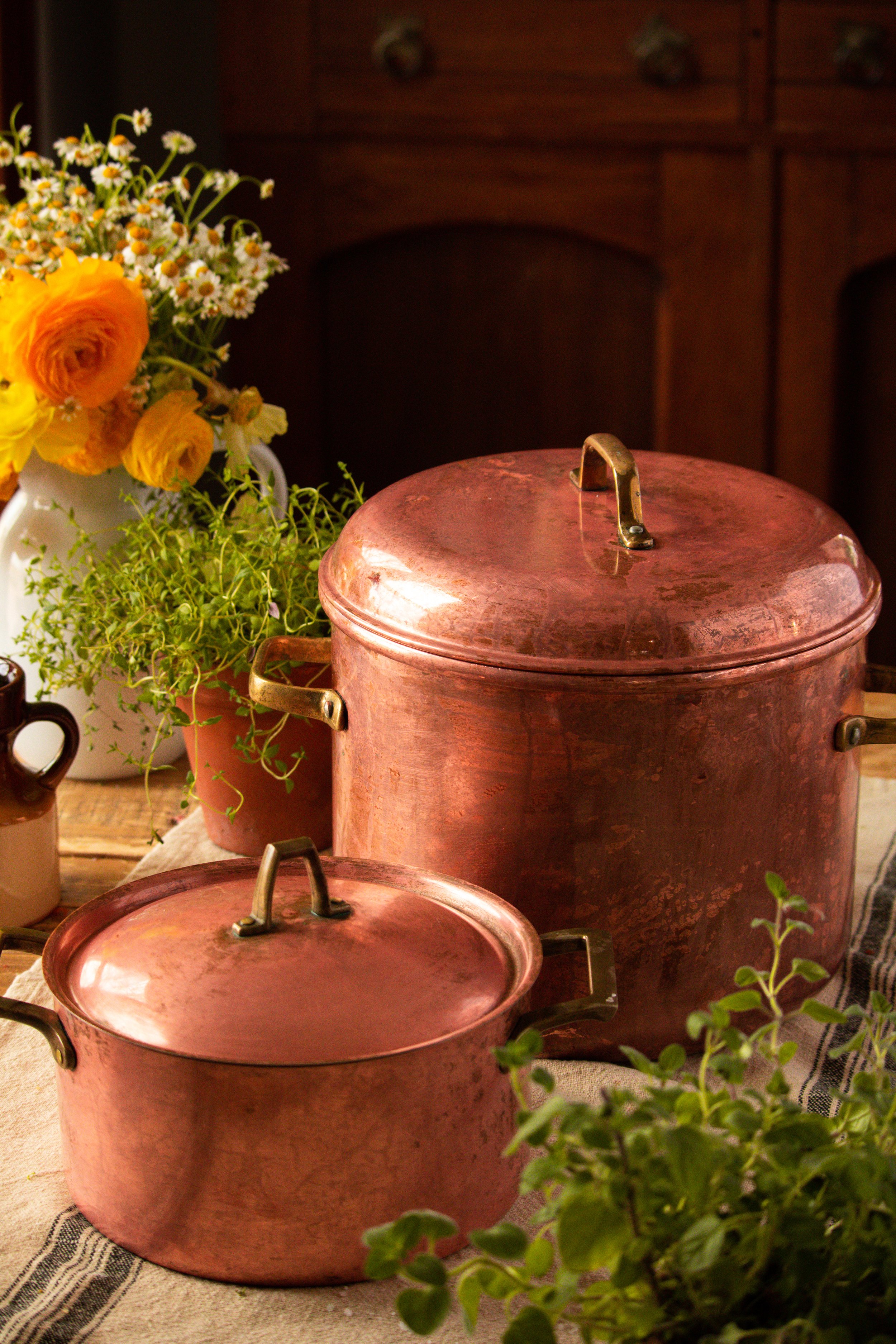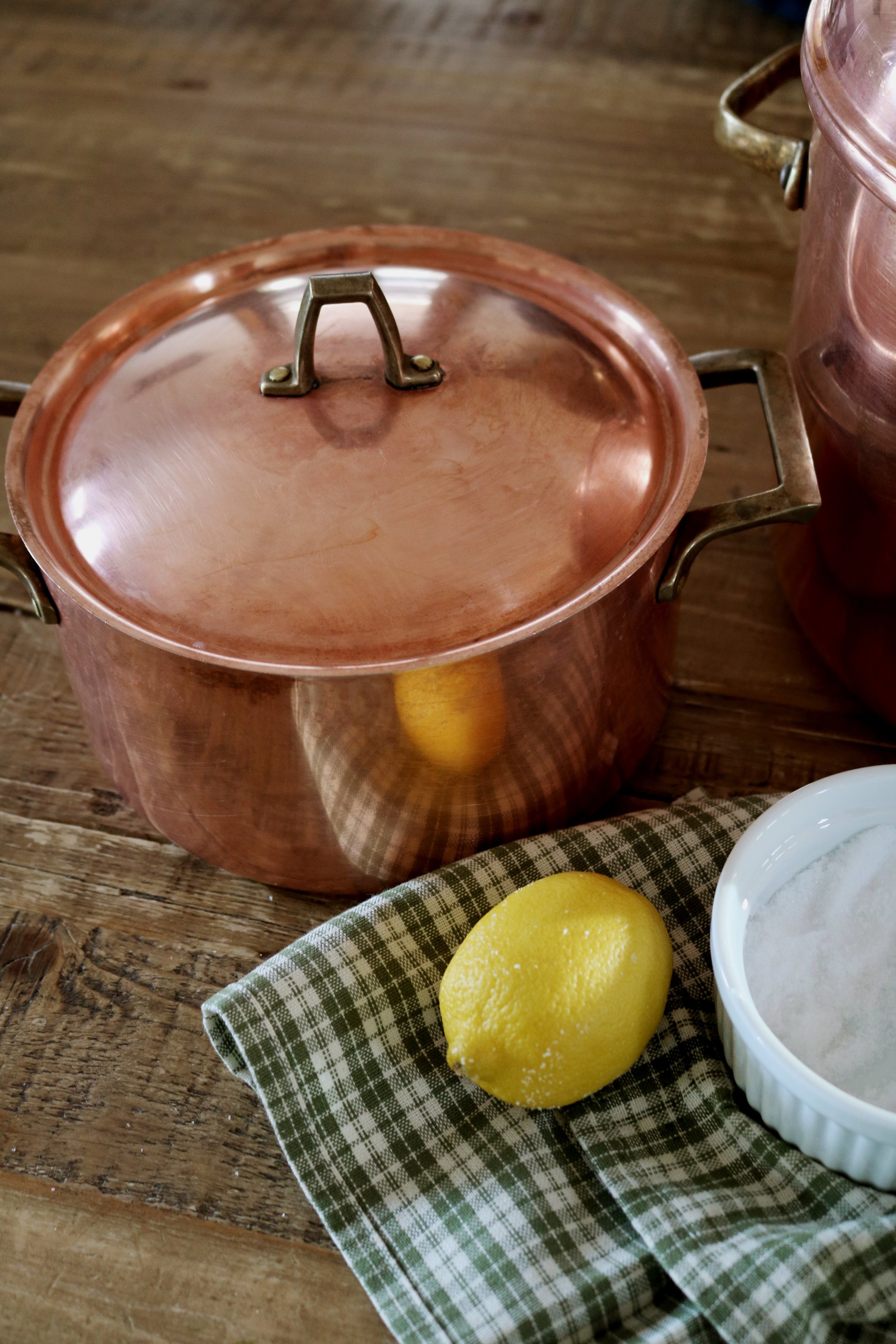How to Care for and Use Copper Pots
I tend to see copper tea kettles everywhere I go, some authentic and others not so much. One can only own so many tea kettles, right? When thrifting, I try to keep my eye out for specific items so as to keep my mind focused: woven baskets, crocks, antique glass bottles and jars, metal cooking utensils, brass candlesticks, and stoneware. Copper cookware also tends to be something I find myself looking for, though it’s much rarer to find for a good deal.
While I was wandering down the aisles of an antique shop some years ago, I came across these two pots for a great price. When turning them over I found the inscription Paul Revere 1801 Signature and knew that I had found a treasure! I scooped them up and brought them home wondering what my next steps were. I have had them for three years now, and they continue to wear with age. For the past six months I thought I had lost them in our move, but I found them buried in our basement a few weeks ago and was happily surprised. They looked a little worse for wear, so it was time for a polish.
Cleaning copper cookware is very easy, at least if you want to use a natural approach. While you could easily purchase a copper cleaner, which would work much better for removing the patina, I find the aged look romantic and endearing. My vintage pots are unfortunately not able to be cooked with because they need to be re-tinned on the inside. Maybe one day I will send them off to be repaired! For now, they sit on my shelf.
What makes copper cookware so amazing? It is one of the best conductors of heat and makes for an incredibly helpful tool in the kitchen. It is known for its ability to heat quickly and stay heated while also cooking your food uniformly. As long as your pots are lined with another non-reactive metal like nickel, tin, or stainless steel they are perfectly safe to cook in. Luckily, my two pots were in perfect shape!
Copper pots are perfect for cooking all sorts of meals as when lined it is similar to cooking in a stainless steel pot or pan. Because of their excellent precision in heat control they make a wonderful tool for for risottos and sauces. You can move from a rapid boil to a simmer in a pinch as opposed to other types of metal.
How to Clean Copper Cookware
Wash and Dry. Use a mild dish soap and wash your pots or pans as usual. Dry thoroughly as any water can lead to the metal tarnishing more quickly.
Buff with Lemon and a Mild Abrasive. Once washed and dried, cut a lemon in half and dip it in sea salt or baking soda (or both!) and rub gently on the surface of the copper. You can even add cornstarch as well if you wish. You will be amazed at the magic of how the once unpolished copper becomes shiny and new again. Don’t worry - this won’t ruin the beautiful patina of an old pot, but will give it some new life.
Polish with Vinegar. Rinse off the lemon juice and salt and dry again. Taking a small drop of distilled white vinegar or olive oil and a soft cloth, polish the pot. This creates a seal to prevent oxidation. Dry and look at that shine!
Still have spots? Try Tomatoes! Tomatoes are acidic and can really shine up a copper pot like no other. Coat the pot in tomato paste or ketchup and let sit for a few minutes. Wash off and polish as usual. If there are some really tough spots, you can use steel wool and detergent, but be careful!
Don’t let the beautiful patina or wearing of a copper pot scare you away when out scouring the antique stores. As long as the inside of pot is lined with a tin or a different metal it is perfectly safe to cook with!
continual care for copper
Be Ready to Cook! Because copper heats up so quickly, you will want to prep your ingredients ahead of time and expect a much faster turn around for your meal.
Cook on Medium-High Heat. Using super high heat on copper can wear through the inner lining faster and result in the pot/pan needing repair (which isn’t cheap!). Using a medium or medium-high heat is best when you are first starting out.
Use Wooden or Silicone Utensils. Tin is very soft and therefore using a stainless steel cooking utensil could damage the lining or scratch it.
Don’t Preheat Your Pots. Yep! You heard right! Copper heats so well and quickly that preheating is not necessary. Just turn up the flame and go!
Searing Does Not Work Well. Because the tin lining can only heat up to 450 degrees F, to sear meats you are better off using cast iron or stainless steel.
Don’t Scrub the Pan. Copper does not usually have the issue of food sticking to the inner surface of the pan, but if you do run into trouble don’t fret. Just soak with warm water and dish soap for about 20 minutes or so. It cleans so much easier than any other metal!
Polish After Each Use. If you wait too long, the wear on any new pots or pans you may get will be much worse. Just polish immediately after washing and watch your pots stay beautiful for years to come.
What do you think of when you see copper cookware? I immediately think of Julia Child. There is definitely a feeling of magic when I pull these down from the shelves and place them on the stove. Part of me likes to imagine I am working on a French masterpiece with the window open and spring breeze rolling in.
xoxo Kayla







